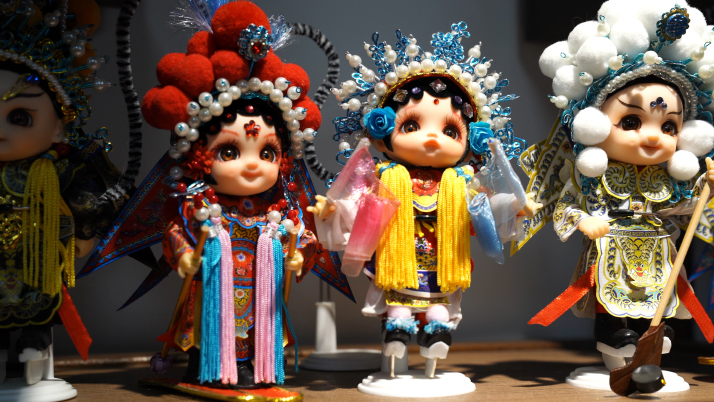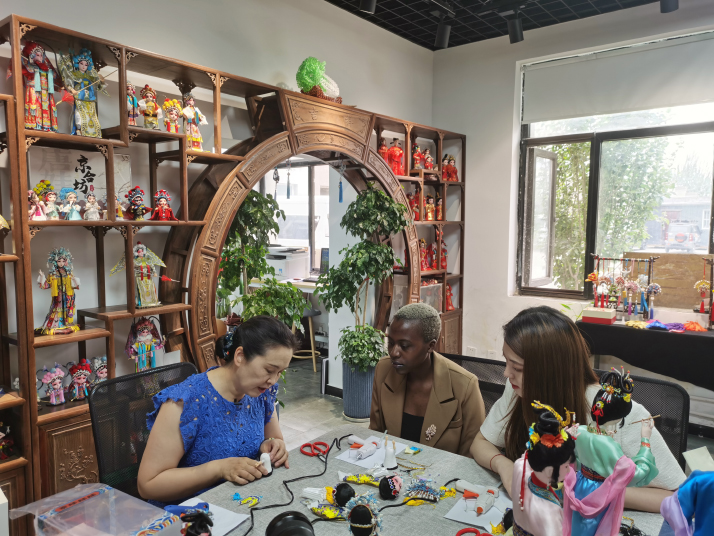Traditional Beijing figurines get a new lease on life
As a form of national-level intangible cultural heritage, the folk art of Beijing silk figurines, boasts a history of more than 1,000 years, dating all the way to the Tang Dynasty (618-907). Usually, the hands and face of a traditional silk figurine are made of natural silk.
To revive the popularity of this traditional figurine among young people, He Mei, an inheritor of the handicraft and founder of Beijing Jinghefang Cultural Development Co. Ltd., is on a quest to adapt the dolls to contemporary times and beyond. Inside her company's workshop, hundreds of figurines glimmering under the bright lights dazzle visitors.
"Everybody on the planet is familiar with American Barbie; I want to turn the Beijing silk figurines into 'Chinese Barbie dolls' of similar recognition," she told Beijing Review.

The reboot
The craft of making Beijing silk figurines was once almost lost as silk is hard to preserve and those figurines unearthed from ancient tombs were hardly identifiable, making them difficult to replicate.
In the 1950s, China was invited to attend an international doll exhibition. To present distinctive Chinese dolls at the event, a group of Chinese artisans combed through ancient archives for images of the Beijing silk figurines. The images were found and recreated. "The recreated figurines made their debut at the exhibition—to wide acclaim. That was the moment Beijing silk figurines returned to the stage," He said.
When she first saw the figurines at a store in Beijing, He was so impressed that she decided to learn the craft from Qi Congying, a famous Beijing silk figurine artist. Going from amateur fan to artisanal pro, He went on to establish her company in 2013. Located in Tongzhou District of Beijing, the business now has around 50 employees.
Many employees hail from the surrounding villages. As some of them knew nothing about creating the figurines prior to starting their job at the company, He encouraged them to learn the skills from scratch. Today, they are experienced workers specializing in different procedures, ranging from painting faces to creating the dolls' clothing.
In one of the company's workshops, three figurines take up a prominent place. They are the most traditional of all Beijing silk figurines, He said. "We feel it is imperative to preserve the old figurines through intricate craftsmanship. A typical production process starts with hand-paint patterns, layer by layer, to make them appear as if embroidered," she said.
But making one figurine involves dozens of procedures, and dozens of skills which are all hard to master, and can take the artisan up to one month. The complicated processes had long restricted the product's promotion. So He started thinking about alternative approaches to mass produce the dolls.
"Thinking about how to pass on the figurine-making craftsmanship, I decided to further upgrade the dolls," He said. Her team adopted resin instead of silk to create their bodies and turned to digital design and machine printing for their clothing patterns. Today, a skilled hand working on joining the figurine parts can put together 20 "bodies" a day.
Traditional Chinese culture is a major source of inspiration for their designs. The first Beijing silk figurines they made were modeled after the various roles in Peking Opera, a cultural gem as well as a visually powerful art form, He said, adding the company has been fine-tuning and upgrading its products for more than a decade.
One of the most remarkable figurines created by He's team in the style of Peking Opera is modeled after the Tang Dynasty royal concubine Yang Yuhuan, often known as Yang Guifei, from the must-see classic The Drunken Concubine. The figurine's wardrobe consists of intricate and delicate pieces and she's even holding a miniature ancient wine vessel. Her elaborate headdress is made using the filigree inlay technique, which in itself has been listed as national intangible culture heritage. To make this type of headgear, craftspeople first shape metal wires into various forms using complex techniques such as knitting and welding, and then mount stones onto the wire patterns.
He's team has also turned well-known characters from other Chinese operas into statuettes. "Given China has several hundred kinds of local operas, we will continue to reproduce these characters," she said. Traditional Chinese literary works such as The Dream of the Red Chamber, a masterpiece written in the Qing Dynasty (1644-1911), too, have inspired the company's designs.
The company has hired some young designers, who have brought fresh ideas into the company, creating new series such as figurines featuring the 12 Chinese Zodiac signs.
"Today, many of our consumers belong to the country's younger generations. So we created miniature dolls, in line with their preferences," He said. She said that they have produced dolls whose hands and feet can be bent and outfits can be changed to enhance the dolls' entertainment value.

Explore more
To make the company's products more appealing, He's team has developed complete DIY kits so people can create a figurine of their own in under an hour. She has presented the kits across many offline fairs and schools in Beijing.
According to He, Beijing silk figurines have again become one of the icons of traditional Chinese culture in international exchanges. During the Beijing 2022 Olympic and Paralympic Winter Games, the company produced figurines characterizing the different athletic disciplines; the dolls were labeled official souvenirs for international visitors.
He's company has also worked together with media outlets to promote the age-old folk art.
After learning how to create the figurine herself when filming with Beijing Review inside the company's workshop, Veronica Ludaka, a student of China Agricultural University, was impressed by the preservation of cultural tradition in China. "I think traditional Chinese culture is so beautiful and has been preserved so well. I can see what it looked like before and how Chinese culture is portrayed now, in the 21st century," Ludaka said.
Through Pili International Multimedia, which has been producing Pili, a glove puppetry show from Taiwan, since 1985, the figurines have been sold to Taiwan Province. "They are very popular there, often sold out soon after being released," He said.
What's more, He's company has even joined forces with robot companies to power their products with technology. The programmed robot dolls can dance and strike several poses.
"The integration of this ancient folk art with other art forms and technology will further kindle people's interest in the art," she said.
(Print Edition Title: All Dolled Up)
Copyedited by Elsbeth van Paridon
